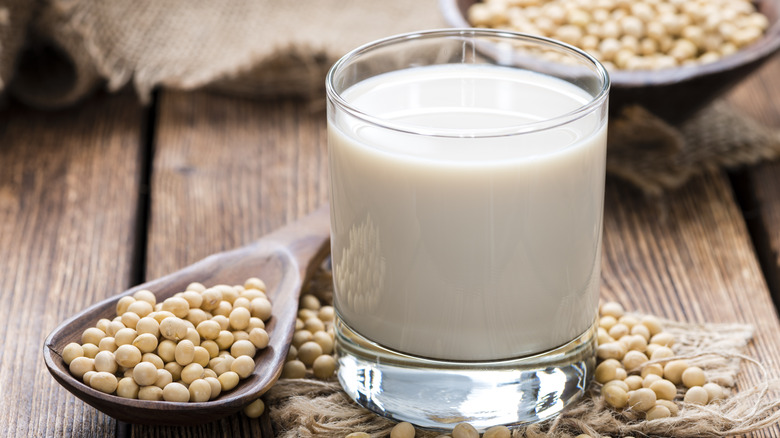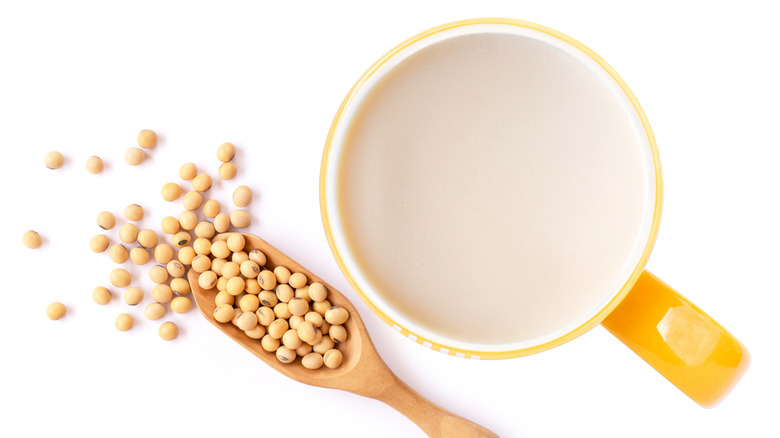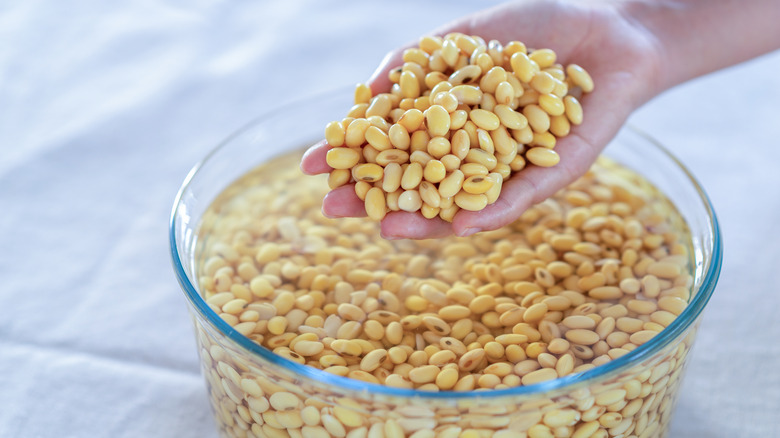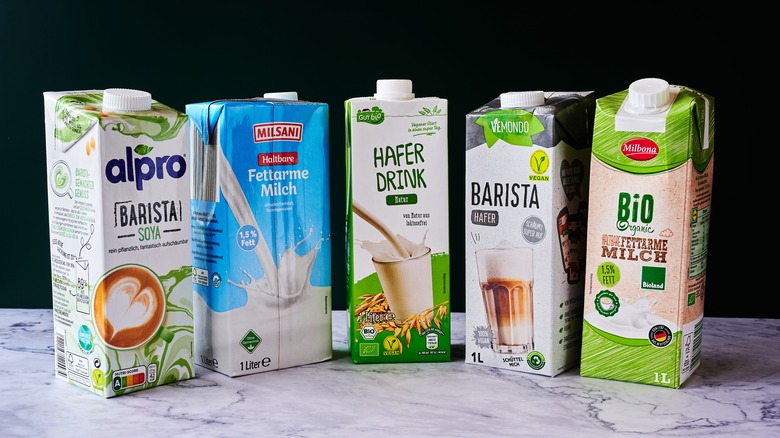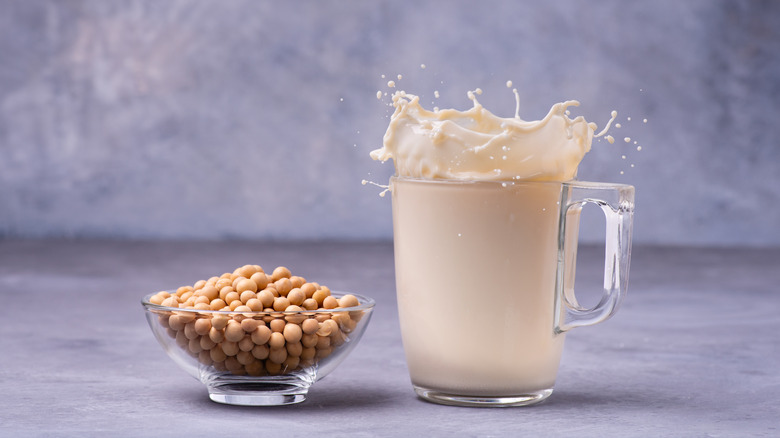Is Fresh Soy Milk Actually Different From Grocery Store Soy Milk?
With all the different plant-based milks available on the market today, it is easy to see why many people hardly give soy milk a second glance. While it might come in different flavors that range from original to chocolate and vanilla, soy milk can hardly be considered exciting, and depending on the brand you buy, the dairy substitute can either be thin and watery or plumped up with additives that include thickeners and stabilizers, which give the beverage a texture closer to dairy.
If you have only tasted American grocery store soy milk, you can be forgiven for thinking this is the best that this particular plant milk is going to get.
Unfortunately, a decades-long push to give soy milk greater appeal in a broader market has meant that mass-produced, grocery soy milk now tastes completely different from its freshly made counterpart. While some might argue that processing has made soy milk taste better, fans of fresh traditional soy milk say that it has been stripped of its flavor, texture, and character that continues to make it a beverage of choice for so many.
How soy milk came to be
While folklore credits the discovery of soy milk to a Chinese prince from the Han dynasty named Liu An, who was said to have extracted milk from soybeans to feed his sick mother, little is recorded about the beverage's history, other than in art and poetry. As a result, we don't know much about when and how soy milk was made and used in east Asia until the early 20th century when Chinese companies began to sell bottled soy milk.
The first of these soy milk makers to make it big was a company named HK Soya Bean Products, a Hong Kong-based company that began mass producing soy milk in 1939 to feed refugee children from China. By that time, soy was already considered the "Chinese cow" because it was a quick and easy source of nutrition for East Asians, a great majority of who are lactose intolerant, per a 2017 study in The Lancet.
After World War II and the Japanese occupation, Lo's company, which renamed itself "Vitasoy," was tapped to help feed school children. It was thanks to Vitasoy's efforts that soy milk became an acknowledged source of protein; it became so popular in Hong Kong that it sold more units than its soft drink counterparts, Coke and Pepsi.
How fresh soy milk is made
Fresh soy milk is made with just soybeans and water. The beans are soaked, ground down, and the liquid is extracted using linen or cheesecloth. The milk is then cooked over medium heat for about five minutes before it is cooled and consumed.
Soy milk can also be made in an electric soy milk maker, which processes the beans so that fresh batches can be ready in minutes. These machines make it possible for fresh soy milk to be made at home, although fresh soy milk can be found at Asian supermarkets, as well as in specialty restaurants in Chinatowns across the country.
Fresh soy milk isn't just enjoyed hot or cold; it can be drunk sweet with just a bit of sugar, or salty, with aromatics and fragrant oils including sesame oil and chili oil added before it is served in a bowl. Food blogger Robyn Eckhardt describes Taiwanese soy milk as "the perfect a.m. beverage, rich enough to satisfy an empty belly, light enough not to weigh you down, refreshing if taken over ice, supremely comforting if drunk warm," per Topics.
Interestingly, soy milk was not a thing in Taiwan until 1953, when a Christian missionary named Harry W. Miller set up a soy milk production line there. Today, it is an important part of the island's most popular breakfasts that include Chinese crullers and wheat pancakes, and it's sold in shops known as soy milk restaurants.
How grocery store soy milk is made
Miller didn't just bring soy milk to Taiwan — he can also be credited for introducing it in America. After he returned from China, Miller opened a factory in Ohio where he pushed the idea that soy milk was safer than cow's milk. Unfortunately for Miller, soy milk didn't take off thanks to its flavor, and because it made drinkers gassy. Still, Miller wasn't the only one who felt soy milk had a future; car maker Henry Ford invested in research that looked into commercial applications for soy byproducts.
American soybean milk underwent a transformation in the 1960s when scientists discovered an enzyme in the liquid called lipoxygenase, which seemed to be responsible for the drink's beany flavor. They also tracked down a band of complex sugars in the beverage called oligosaccharides which made soy milk drinkers gassy.
Those discoveries helped commercial soy milk factories produce the dairy substitute they felt everyone could enjoy. From there, manufacturers added flavors and tweaked its texture to make it more palatable to western, mass-market consumers.
To improve its mouthfeel and shelf life, Healthline says stabilizers and thickeners were eventually added to make the beverage even more like the dairy available in groceries today.
Additives have made it a different product
A growing interest in tofu as a meat alternative may mean all the tweaks intended to make soy milk appeal to a wider audience may not be as popular among fans today. After all, fresh soy milk not only has the same flavor profile as tofu, but it is also one of the byproducts of tofu manufacturing.
Fresh soy milk also delivers for those who are looking for a more organic beverage because it has a straightforward list of ingredients. Aside from soybeans and water, it will have sugar if it is sweetened, or condiments and aromatics like soy sauce, scallions, and shallots if it is savory. By contrast, a box of Silk original soymilk lists filtered water, soybeans, cane sugar, Tricalcium Phosphate, Calcium Carbonate, Vitamin A Palmitate, Vitamin D2, Riboflavin [B2], Vitamin B12), Sea Salt, Natural Flavor, as well as Gellan Gum, making grocery soy milk a wholly different — albeit more shelf-stable — product.
All the work that has gone into making mass-market soy milk does have one visible benefit — fresh soy milk doesn't work well when it is added to other beverages like coffee, and even for those who prefer fresh soy milk, commercial soy milk is needed to turn out the soy lattes that customers want, even when it's served in Asia, where fresh soy milk continues to be preferred.
